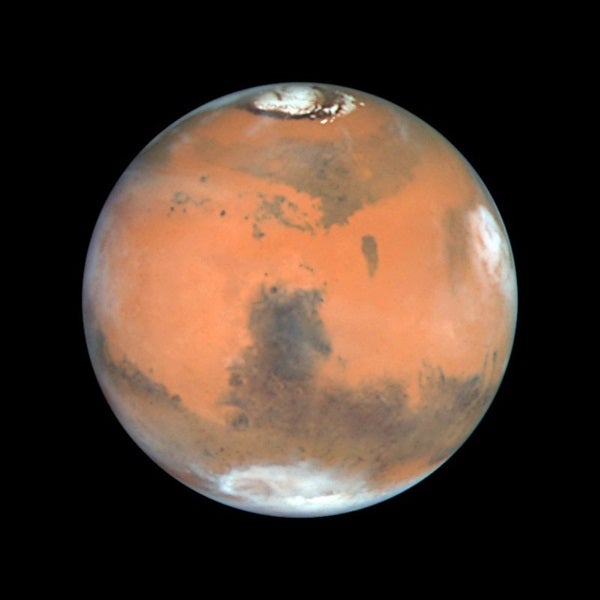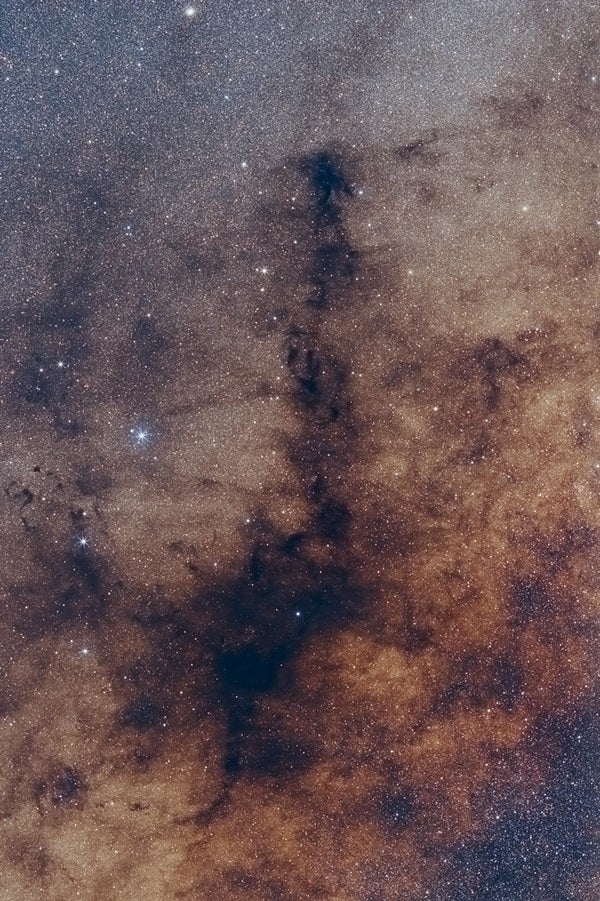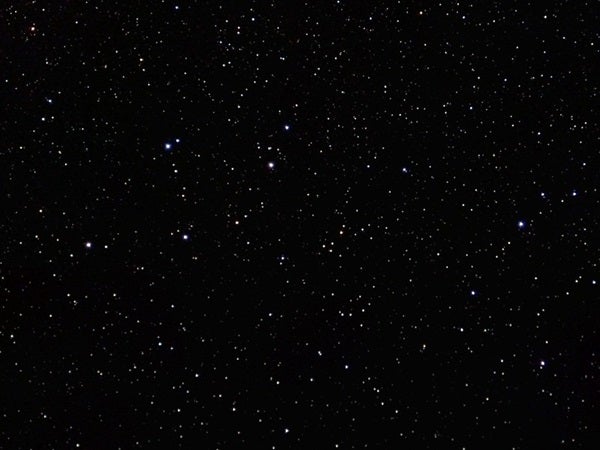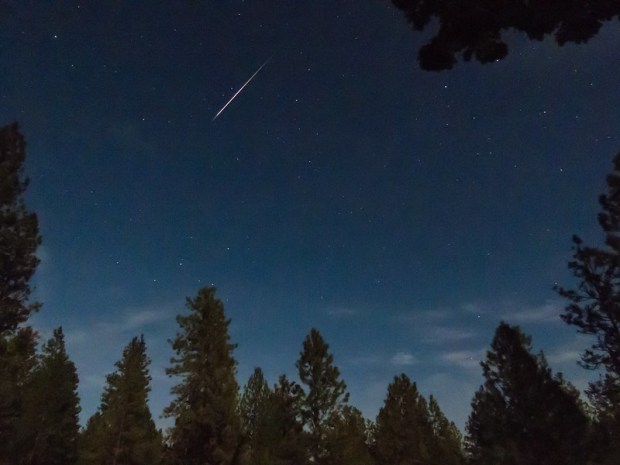Last Quarter Moon occurs at 8:40 P.M. EDT tonight. Because our satellite doesn’t rise until nearly midnight, use the evening window of darkness to target a familiar favorite: M27, also known as the Dumbbell Nebula. You’ll find it high in the sky, within the borders of the lesser-known constellation Vulpecula the Fox. For a brighter signpost, find Albireo in Cygnus, then scan about 8.3° southwest to find M27.
This planetary nebula was the first such object ever discovered and is one of only four planetary nebulae in Messier’s catalog. It represents the end stages in the life of a Sun-like star that is now blowing away its outer atmosphere in a bubble. The core of the star, which lies at the center of the nebula, is still shining enough to illuminate the sloughed-off gas and dust.
The nebula is named for its distinct shape: slimmer in the center and wider at the ends. But appearances can be deceiving — the entire shell of gas and dust is spherical, but because it is so thin, we see straight through the center but look through more material at the edges. At the eyepiece of a larger scope, you may even catch the gas’ eerie greenish cast.
Sunrise*: 7:05 A.M.
Sunset: 6:28 P.M.
Moonrise: 11:40 P.M.
Moonset: 2:17 P.M.
Moon Phase: Waning gibbous (53%)
*Times for sunrise, sunset, moonrise, and moonset are given in local time from 40° N 90° W. The Moon’s illumination is given at 12 P.M. local time from the same location.
Saturday, October 10
Venus passes 2.7° south of the spiral galaxy M95 this morning. To see the cosmic meetup, look east with a telescope in the two hours before sunrise — the earlier the better, as M95’s dim, magnitude 11 glow will be harder to pick out as the sky grows lighter. Contrast that with Venus, whose 75-percent-lit disk rules the region at magnitude –4.1. Leo’s brightest star, Regulus, lies nearly 9° west-northwest of Venus and shines at magnitude 1.4.
But M95 isn’t the only galaxy within the celestial lion’s domain. With a waning crescent Moon relatively far away in Gemini, keep your attention in Leo and look about halfway between Venus and the tip of the lion’s tail, Denebola. There you’ll find the famous Leo Triplet, also known as the M66 Group. It includes three galaxies: M65, M66, and NGC 3628. Although the best time to view galaxies is under a completely dark sky when they’re high above the horizon, your patience this morning may pay off with a glimpse of their fuzzy, bright cores. M66 is brightest (magnitude 9), so search it out first, then use averted vision to see if you can catch its two magnitude 10 companions as well.
Sunrise: 7:06 A.M.
Sunset: 6:27 P.M.
Moonrise: —
Moonset: 3:07 P.M.
Moon Phase: Waning crescent (43%)
Comet 88P/Howell passes less than 2° from the bowl of the Pipe Nebula this evening. They’re already low in the southwest an hour after sunset, so leverage what darkness you can before it gets too late to look for the pair. A 4-inch scope under dark, country skies should nab them, but you’ll want a larger instrument in more light-polluted locales. In that smaller scope, Howell will likely appear as a gray fuzz; in larger scopes, you may glimpse a greenish glow surrounding the nucleus. The comet is 2.5° east-southeast of magnitude 3.3 Theta (θ) Ophiuchi.
The Pipe Nebula is a dark nebula of obscuring gas and dust that block starlight beyond it, making it look like an inky spot of “nothingness” on the sky. It is visible to the naked eye under dark skies, so try your luck on this moonless night before pulling out any optical aid. The entire Pipe structure is 7° long; its bowl is also cataloged as Barnard 78, while Barnard 59, 65, 66, and 67 create the pipe’s stem.
Sunrise: 7:07 A.M.
Sunset: 6:25 P.M.
Moonrise: 12:41 A.M.
Moonset: 3:51 P.M.
Moon Phase: Waning crescent (33%)
Monday, October 12
The constellation Cetus the Whale is rising in the southeast as darkness falls. You can track it over the next few hours, as its stars climb higher in the sky. Focus in on one star in particular: the variable star Mira, whose very name means “wonderful.”
You can find Mira, also cataloged as Omicron (ο) Ceti, roughly in the center of the constellation, about one-third of the way on a line drawn southwest from Menkar (magnitude 2.5) toward Diphda (magnitude 2). Mira is a long-period variable, swinging from 2nd to 10th magnitude and back over the course of 332 days. That means its brightness changes by a factor of 1,600 between its brightest and its dimmest.
Consider visiting this variable once every one to two weeks this fall and winter to see if you can note its change over time in comparison to other, nearby stars. You can check out Phil Harrington’s column in Astronomy’s October 2020 issue for more details on this wonderful little star and step-by-step instructions on how to track its brightness in the coming months.
Sunrise: 7:08 A.M.
Sunset: 6:24 P.M.
Moonrise: 1:49 A.M.
Moonset: 4:30 P.M.
Moon Phase: Waning crescent (23%)
Tuesday, October 13
The big night is finally here: Mars reaches opposition at 7 P.M. EDT, just one week after its closest approach to Earth. It’s blazing at magnitude –2.6 in the southeast, amid the stars of Pisces and about 10° high in the east an hour after sunset. It will climb higher as the hours tick by; the best time to observe the Red Planet is late this evening in the hours leading up to local midnight, when it is high above the horizon. It’s in a relatively dark part of the sky and in a faint constellation, so it will be easy to pick out, thanks to its brightness and its distinctive red color.
See Mars at its best
The Moon passes 4° north of Venus at 8 P.M. EDT, although both are still below the horizon. We’ll come back to them in just a few hours.
Mercury is stationary at midnight EDT. It’s well below the horizon by then, but you can view it tomorrow at sunset.
Sunrise: 7:09 A.M.
Sunset: 6:22 P.M.
Moonrise: 3:01 A.M.
Moonset: 5:05 P.M.
Moon Phase: Waning crescent (14%)
Wednesday, October 14
Today holds amazing solar system sights for both morning and evening observers. For those up before the Sun, you can spot the delicate crescent Moon — with just eight percent of its surface lit — join the planet Venus in the morning sky. Look east in the two hours before sunrise to glimpse the pair in the southern portion of Leo the Lion, about 9° southwest of Denebola (which you may remember from earlier this week marks the tip of Leo’s tail). See if you can spot any earthshine on the lunar surface, which occurs when sunlight bounces off Earth and lights up the portion of the Moon in Earth’s shadow.
Lucky — and speedy — evening observers can catch magnitude 0.9 Mercury low in the western sky at sunset tonight. It’s only 5° high as the Sun sinks below the horizon and is completely gone within about 30 minutes.
As Mercury disappears, look to its north. Higher above the horizon, you’ll see the bright star Arcturus in Boötes pop out in the darkening twilight. This red giant shines 113 times more brightly than our Sun and weighs about one-and-a-half times as much as our star.
Sunrise: 7:10 A.M.
Sunset: 6:21 P.M.
Moonrise: 4:15 A.M.
Moonset: 5:37 P.M.
Moon Phase: Waning crescent (7%)
Thursday, October 15
Jupiter and Saturn set before local midnight in the south, still embedded within the stars of Sagittarius. You can find the giant planets to the northeast (upper left) of the Teapot asterism. The two planets are currently just under 6.5° apart, with magnitude 0.5 Saturn east of magnitude –2.3 Jupiter.
Tonight, focus in on Jupiter with binoculars or a telescope after dark to see all four of its largest moons off to the planet’s east. But not for long — just after 9:40 P.M. EDT, the closest moon, Io, slips onto the disk. About 80 minutes later, its shadow follows, as Io is already more than halfway across Jupiter’s face. Jupiter is still about 4° above the horizon for observers at 40° north latitude when Io leaves the planet’s western limb just before midnight EDT. Observers on the East Coast and in the Midwest won’t get to see Io’s shadow disappear (around 1:13 A.M. EDT) before the planet sets, but West Coast observers will be able to catch the show’s finale.
Sunrise: 7:11 A.M.
Sunset: 6:19 P.M.
Moonrise: 5:30 A.M.
Moonset: 6:07 P.M.
Moon Phase: Waning crescent (2%)
New Moon occurs at 3:31 P.M. EDT. The Moon is also at perigee today, the closest point in its orbit to Earth. It currently sits 221,775 miles (356,912 kilometers) away.
New Moon is the best time to seek out dim objects — and constellations — washed out by our satellite’s bright glare. Tonight, try to catch Delphinus the Dolphin high in the southwest after dark. This tiny constellation, which ranks 69th in size among the 88 official constellations, consists of four stars that form the dolphin’s body, as well as one additional star that marks its tail. The four stars of Delphinus’ body also create an asterism known as Job’s Coffin, which measures just 1.3° by 2.7°.
Although this aquatic constellation may not look like much to the naked eye, turning binoculars or a small scope on the region can bring out a wealth of field stars to enjoy on a dark night like tonight.
Sunrise: 7:12 A.M.
Sunset: 6:18 P.M.
Moonrise: 6:46 A.M.
Moonset: 6:38 P.M.
Moon Phase: New (0%)













